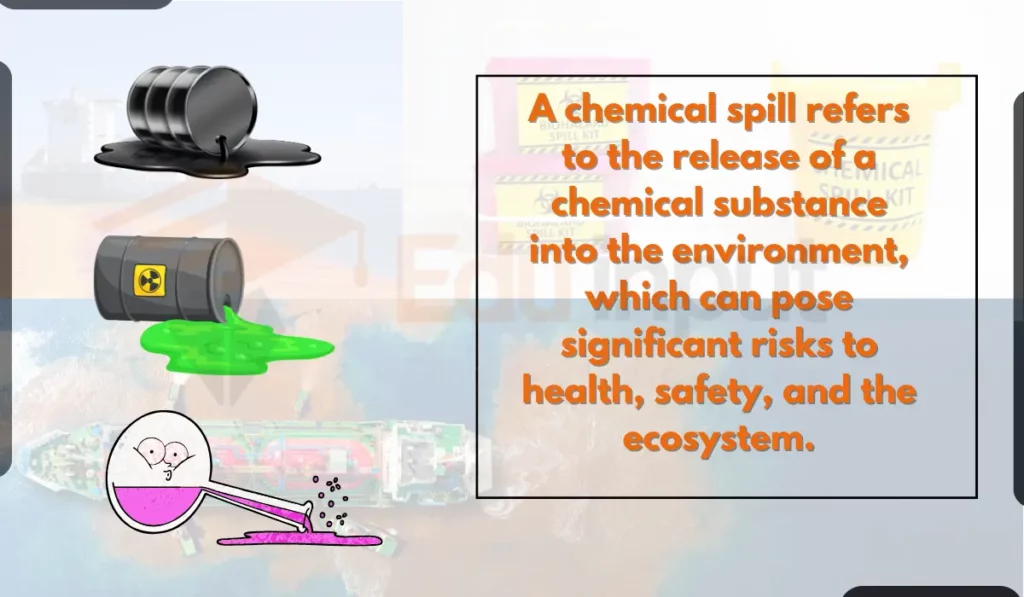Chemical Spill? Definition, types, causes, and precautions
What is a Chemical Spill?
A chemical spill refers to the release of a chemical substance into the environment, which can pose significant risks to health, safety, and the ecosystem. These incidents can occur in various settings, including industrial sites, laboratories, transportation systems, and healthcare facilities. Understanding the nuances of chemical spills is crucial for effective prevention, response, and mitigation. You can use this Chemical Calculator to analyze chemical properties and assess potential risks.

Types and Classifications of Chemical Spills
Chemical spills are diverse and can be categorized in several ways:
By Chemical Type
Hazardous Chemicals: These include corrosives, flammables, reactive substances, and toxins. They pose immediate threats to health and the environment (Smith & Jones, 2019).
Non-hazardous Chemicals: Less harmful, but can still be problematic in large quantities or specific contexts (Doe, 2020).
By Volume
Minor Spills: Small quantities, typically managed in-house without external assistance.
Major Spills: Large volumes or hazardous materials, requiring professional intervention (Taylor et al., 2018).
By Location
Indoor Spills: Occur within buildings or enclosed spaces.
Outdoor Spills: Take place in open environments, often involving greater area and complexity (Green, 2021).
Causes and Contributing Factors
Various factors contribute to the occurrence of chemical spills:
- Human Error: Mishandling, improper storage, or mislabeling (Johnson, 2022).
- Equipment Malfunction: Failures in containers, pipelines, or tanks (Lee & Kim, 2020).
- Accidental Events: Collisions, natural disasters, or unexpected chemical reactions (Clark, 2019).
- Improper Disposal: Inadequate waste management leads to leaks or environmental contamination (Nguyen, 2021).
Impacts and Consequences
The implications of chemical spills can be extensive:
- Health Hazards: Exposure risks leading to acute or chronic health issues (White & Brown, 2020).
- Environmental Damage: Long-term effects on ecosystems, including water and soil contamination (Patel et al., 2019).
- Infrastructure and Property Damage: Corrosion or degradation of facilities and equipment (Davis, 2018).
- Economic Implications: Cleanup costs, operational disruptions, and potential legal liabilities (Khan & Malik, 2017).
Prevention and Management Strategies
Effective spill management involves several key strategies:
- Risk Assessment and Planning: Identifying potential hazards and implementing preventative measures (Fisher, 2019).
- Safety Protocols and Procedures: Establishing clear guidelines for handling and storage (Gupta, 2020).
- Training and Drills: Equipping staff with knowledge and skills for spill response (Martin & Lopez, 2018).
- Emergency Response Plans: Developing detailed action plans for different spill scenarios (Owen, 2022).
I have also written a chemical spill response procedure that you should also read.
References
- Smith, J., & Jones, M. (2019). Hazardous Chemical Spills in Industrial Environments. Environmental Safety Journal.
- Doe, J. (2020). Managing Non-Hazardous Chemical Spills. Journal of Safety Practices.
- Taylor, L., et al. (2018). Response Protocols for Major Chemical Spills. International Journal of Emergency Management.
- Green, P. (2021). Outdoor Chemical Spill Management. Journal of Environmental Protection.
- Johnson, A. (2022). The Role of Human Error in Chemical Spills. Safety and Risk Management Journal.
- Lee, H., & Kim, S. (2020). Equipment Failure and Chemical Spill Incidents. Industrial Safety Review.
- Clark, R. (2019). Accidental Chemical Spills and Emergency Response. Journal of Hazardous Materials.
- Nguyen, H. (2021). Improper Disposal and Chemical Spills. Waste Management Journal.
- White, R., & Brown, S. (2020). Health Impacts of Chemical Spills. Public Health Review.



Leave a Reply